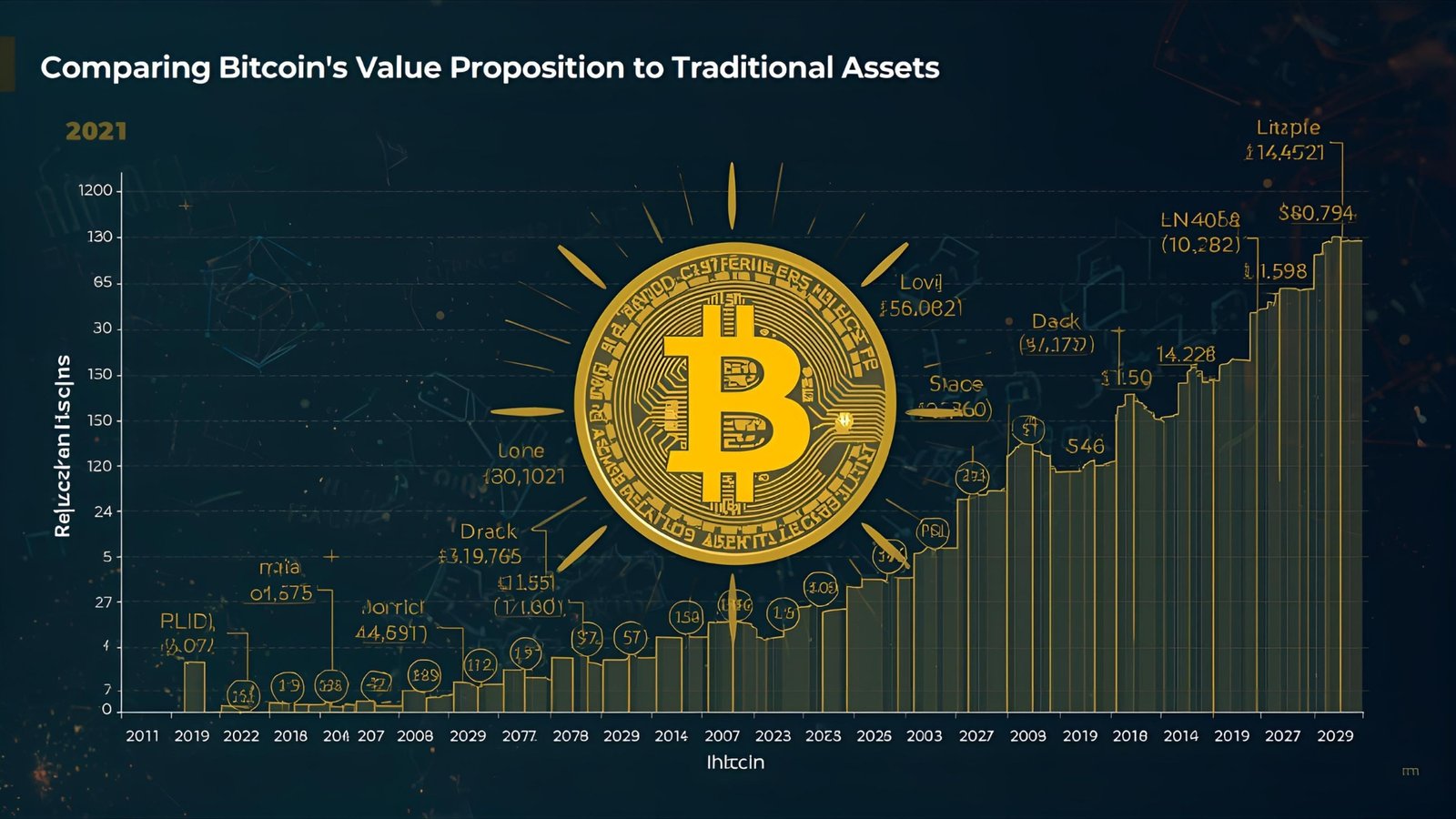Bitcoin October Slowdown Hides Strength vs Gold Rally
Bitcoin October Slowdown Hides Strength while gold hits records. Analysts predict a BTC catch-up rally driven by ETF inflows and Fed policy.

Bitcoin’s price stability signals underlying strength rather than weakness. This counterintuitive interpretation has sparked widespread discussion among investors about the digital asset’s trajectory and its relationship with traditional safe-haven assets.
The current market environment presents a fascinating contrast between two distinct asset classes competing for investor attention. While precious metals have captured headlines with record-breaking valuations, the leading cryptocurrency has demonstrated remarkable steadiness in the face of global economic uncertainty. Understanding this dynamic requires a deeper examination of the forces shaping both markets and the structural factors that could drive a significant Bitcoin rally in the coming weeks.
Bitcoin’s Current Market Position: Bitcoin October Slowdown Hides Strength
Bitcoin’s performance near the $111,000 level has remained steady despite pressure from various market forces. This price action, though lacking the explosive gains typically associated with October, represents a significant achievement given the broader macroeconomic backdrop. The cryptocurrency’s resilience in maintaining this elevated price range demonstrates a fundamental shift in market dynamics compared to previous cycles.
The digital currency landscape has evolved considerably over recent years, with institutional participation fundamentally altering how Bitcoin responds to market volatility. Unlike previous bear markets, where dramatic selloffs dominated price action, the current environment shows sophisticated investors viewing pullbacks as accumulation opportunities rather than reasons to exit positions. This behavioral shift reflects growing confidence in Bitcoin’s long-term value proposition as a store of value asset.
Market participants have observed that despite gold and silver reaching unprecedented highs, Bitcoin has avoided the severe corrections that might have occurred in earlier market cycles. This relative stability suggests that a more mature investor base has emerged, one that understands the asset’s volatility characteristics and maintains conviction through short-term fluctuations. The presence of exchange-traded funds and regulated custody solutions has provided additional infrastructure supporting this newfound resilience.
The Gold Rally and Its Implications for Bitcoin
Gold and silver have surged to record highs while Bitcoin remained under pressure, creating what some analysts view as a temporary divergence that cannot persist indefinitely. The precious metals rally has been driven by geopolitical tensions, inflation concerns, and central bank purchasing activity. However, this same macroeconomic environment that favors gold should theoretically support Bitcoin as well, given its properties as a digital store of value.
The relationship between Bitcoin and gold has become increasingly important to market observers, particularly as both assets compete for similar investor allocations within portfolios. Analysts suggest that roughly half of gold’s value reflects its use as a store of value rather than industrial or jewelry demand, and younger consumers in emerging markets increasingly prefer Bitcoin. This generational shift in preference patterns could accelerate the flow of capital from traditional precious metals into digital assets.
Gold’s recent performance near $4,000 per ounce has established new benchmarks for hard assets during times of economic uncertainty. The precious metal’s strength reflects enduring demand from central banks, institutional investors, and individuals seeking protection against currency debasement. However, Bitcoin advocates argue that the cryptocurrency offers superior properties for wealth preservation, including divisibility, portability, and scarcity guaranteed by its fixed supply schedule.
The concept of Bitcoin as “digital gold” has gained credibility among mainstream financial institutions, with several major investment firms now recommending allocations to both assets within diversified portfolios. This institutional endorsement represents a significant milestone in cryptocurrency adoption and suggests that capital flows could shift dramatically if Bitcoin demonstrates the ability to capture even a fraction of gold’s total market capitalization.
Analyst Perspectives on Bitcoin’s Underlying Strength
Prominent market analysts have offered compelling arguments for why Bitcoin’s current consolidation should be interpreted positively rather than as a sign of weakness. Quinn Thompson, founder of Lekker Capital, noted that Bitcoin’s durability through global uncertainty underscores how structural demand continues to provide a floor. This observation highlights the importance of understanding market structure rather than focusing solely on short-term price movements.
Matt Mena, a crypto research analyst at 21Shares, emphasized that structural demand anchored by ETF inflows and a more dovish policy outlook continues to provide support. The presence of these institutional investment vehicles has created consistent buying pressure that was absent in previous market cycles. Exchange-traded funds have democratized access to Bitcoin exposure, allowing traditional investors to gain cryptocurrency exposure through familiar brokerage accounts without navigating complex custody solutions.
The flushing out of excessive leverage from the market has also contributed to a healthier foundation for future growth. Mena projects Bitcoin could climb to $150,000 before year-end, with leverage flushed out and monetary easing approaching. This bullish outlook rests on several key assumptions about macroeconomic conditions and continued institutional adoption, but it reflects growing confidence among professional analysts that Bitcoin’s fundamental value proposition remains intact.
Additional perspectives from across the industry suggest that Bitcoin’s October performance aligns with historical patterns when accounting for the maturation of the market. The cryptocurrency has established a track record of powerful rallies following periods of consolidation, particularly when fundamental conditions improve. The current environment, characterized by supportive monetary policy and increasing institutional participation, mirrors conditions that have preceded previous bull markets.
Monetary Policy and Federal Reserve Influence
The Federal Reserve’s policy trajectory has emerged as perhaps the most critical factor influencing both traditional markets and digital assets. The Fed’s Beige Book reported signs of growing weakness in the labor market, suggesting market anticipation of rate cuts remains on track. This softening in economic conditions has significant implications for asset prices across the board, as lower interest rates typically support higher valuations for risk assets.
Fed Chair Jerome Powell acknowledged softness in the labor market during recent remarks, reinforcing market belief that further policy easing is on the table. The central bank’s willingness to maintain accommodative monetary conditions creates a favorable backdrop for assets like Bitcoin that compete with traditional savings vehicles. When interest rates decline, the opportunity cost of holding non-yielding assets decreases, potentially driving flows into alternative stores of value.
The relationship between Federal Reserve policy and cryptocurrency valuations has become increasingly evident as Bitcoin has matured. During periods of aggressive monetary tightening, Bitcoin experienced significant pressure as investors favored assets offering guaranteed returns through interest-bearing securities. Conversely, environments characterized by low or negative real interest rates have historically coincided with strong cryptocurrency performance.
Market participants are closely monitoring upcoming Federal Open Market Committee meetings for additional signals about the pace and magnitude of policy adjustments. The consensus expectation for continued rate cuts through the remainder of 2025 has provided support across risk assets, though Bitcoin’s response has been more muted than some observers anticipated. This divergence may simply reflect timing considerations, with the cryptocurrency potentially lagging traditional markets in responding to improved monetary conditions.
ETF Inflows and Institutional Demand Drivers
The introduction of spot Bitcoin exchange-traded funds has fundamentally transformed the cryptocurrency investment landscape. Spot Bitcoin ETFs in the U.S. have drawn over $50 billion in cumulative inflows, signaling deepening institutional participation and a maturing investor base. These investment vehicles have eliminated many of the technical barriers that previously prevented traditional investors from gaining Bitcoin exposure, creating a new channel for sustained capital inflows.
The consistency of ETF demand has provided crucial support during periods when speculative retail interest has waned. Unlike previous market cycles dominated by retail investor sentiment, the current environment benefits from steadier institutional buying that continues regardless of short-term price fluctuations. This structural shift has reduced volatility and created a more predictable baseline for Bitcoin demand.
Financial advisors and wealth managers have increasingly recommended Bitcoin allocations within diversified portfolios, typically suggesting exposure in the one to five percent range. This institutional endorsement represents a dramatic shift from just a few years ago when cryptocurrency was largely dismissed by traditional finance. The availability of regulated ETF products has made these recommendations practical and has opened Bitcoin exposure to trillions of dollars in professionally managed assets.
The impact of ETF inflows extends beyond simply providing buying pressure. These products have also improved market liquidity and price discovery mechanisms, making Bitcoin more attractive to larger institutional investors who require efficient entry and exit capabilities. The presence of multiple competing ETF products has created a competitive dynamic that benefits investors through lower fees and improved product features.
Technical Analysis and Market Structure Considerations
From a technical analysis perspective, Bitcoin’s current price action reveals important clues about market structure and potential future movements. The cryptocurrency’s ability to maintain support near $110,000 despite selling pressure suggests that this level has become an important accumulation zone for longer-term investors. Technical indicators show signs of consolidation rather than distribution, implying that selling pressure may be exhausted.
Over the past ten years, Bitcoin has posted an average October return of twenty percent, far ahead of other months. This historical pattern, often referred to as “Uptober” within the cryptocurrency community, has created expectations for strong seasonal performance. While current gains have been more modest than the historical average, the month is not yet complete, and previous Octobers have frequently featured late-month acceleration in price appreciation.
The relationship between Bitcoin’s price and its moving averages provides additional insight into market sentiment. The cryptocurrency’s interaction with key exponential moving averages during this consolidation phase will likely determine whether accumulation continues or whether additional downside exploration occurs. Successful defense of support levels combined with improving momentum indicators would strengthen the case for an imminent rally.
Market structure analysis reveals that leverage has been substantially reduced from elevated levels observed earlier in the year. This deleveraging process, while painful for overleveraged traders, creates a healthier foundation for sustained price appreciation. Markets that rally from lower leverage positions tend to exhibit more durability than those driven primarily by speculative excess.
Comparing Bitcoin’s Value Proposition to Traditional Assets
The ongoing debate about Bitcoin’s role as a portfolio diversification tool has intensified as both cryptocurrencies and traditional safe-haven assets have demonstrated strength. Bitcoin’s non-correlated behavior may appeal to allocators seeking diversification, particularly as equity valuations remain stretched. This characteristic distinguishes Bitcoin from most traditional assets, which tend to exhibit higher correlations during periods of market stress.
The cryptocurrency’s fixed supply schedule represents perhaps its most compelling feature when compared to fiat currencies and even precious metals. While gold’s supply increases gradually through mining operations, Bitcoin’s issuance rate follows a predetermined schedule that will eventually reach its maximum of twenty-one million coins. This absolute scarcity creates a fundamentally different value proposition than assets subject to supply expansion.
Bitcoin’s digital nature provides advantages in terms of divisibility, transferability, and verifiability that physical assets cannot match. These properties make the cryptocurrency particularly attractive for international transactions and for investors concerned about seizure risk or geographic portability. The ability to memorize a seed phrase and reconstruct a Bitcoin wallet anywhere in the world represents a unique form of wealth protection unavailable with physical assets.
Critics of Bitcoin point to its volatility and lack of cash flows as weaknesses compared to traditional investments. However, proponents argue that volatility has been steadily declining as the market matures and that the asset’s scarcity provides a form of implicit yield through purchasing power appreciation over time. The debate between these perspectives continues to shape institutional adoption decisions.
Macroeconomic Factors Supporting the Catch-Up Narrative
U.S. Treasury yields have eased toward 4.1 percent, reducing the opportunity cost of holding non-yielding assets such as Bitcoin. This development in fixed income markets has important implications for asset allocation decisions, as lower yields make alternative investments more attractive on a relative basis. The compression in real yields after accounting for inflation further enhances the appeal of hard assets with limited supply.
Global economic uncertainty remains elevated, with ongoing geopolitical tensions, trade disputes, and concerns about sovereign debt sustainability creating demand for alternative stores of value. Bitcoin’s emergence during the previous financial crisis positioned it as a hedge against monetary excess and financial system fragility. These concerns have only intensified in recent years, potentially driving additional demand for decentralized alternatives to traditional finance.
The erosion of purchasing power through inflation represents an ongoing concern for savers and investors globally. While official inflation metrics have moderated from recent peaks, many economists argue that real inflation remains significantly higher than reported figures suggest. Bitcoin’s fixed supply makes it inherently deflationary, providing protection against currency debasement that cannot be obtained through traditional savings vehicles.
Emerging market investors have shown particular interest in Bitcoin as a means of protecting wealth from local currency instability. Countries experiencing high inflation or capital controls have seen substantial cryptocurrency adoption, demonstrating the asset’s utility beyond speculative investment. This use case provides fundamental demand that exists independently of price speculation and strengthens Bitcoin’s long-term value proposition.
Future Outlook and Price Predictions for Bitcoin
Looking ahead, VanEck’s Matthew Sigel predicts Bitcoin could reach an equivalent value of $644,000 by the 2028 halving event, representing a potential gain exceeding four hundred percent from current levels. This aggressive forecast assumes Bitcoin captures approximately half of gold’s store-of-value market capitalization as generational wealth transfer accelerates and younger investors increasingly prefer digital assets. While such predictions should be viewed with appropriate skepticism, they reflect growing institutional confidence in Bitcoin’s long-term trajectory.
More conservative near-term forecasts suggest that Bitcoin could establish new all-time highs in the $150,000 to $200,000 range within the next twelve to eighteen months, following typical post-halving cycle patterns. The April 2024 halving event, which reduced new Bitcoin issuance by half, creates supply constraints that have historically preceded significant price appreciation. The lag between halving events and peak prices has been consistent across previous cycles, suggesting that major gains may still lie ahead.
The path toward higher prices will likely involve continued consolidation phases and periodic corrections that test investor conviction. Bitcoin’s maturation as an asset class has reduced but not eliminated volatility, meaning that substantial drawdowns remain possible even within broader uptrends. Investors should maintain appropriate risk management practices and avoid excessive leverage regardless of bullish forecasts.
Ultimately, Bitcoin’s price trajectory will depend on the interplay between macroeconomic conditions, institutional adoption trends, regulatory developments, and technological innovations within the cryptocurrency ecosystem. The convergence of favorable factors across multiple dimensions suggests that the current consolidation may indeed be masking underlying strength that will manifest through higher prices in the months ahead.
Conclusion
Bitcoin’s October performance, while less spectacular than historical averages, reflects a maturing market characterized by institutional participation and structural demand rather than speculative excess. The cryptocurrency’s resilience near $110,000 despite gold’s record-breaking rally demonstrates fundamental strength that analysts believe will eventually translate into a catch-up rally. The combination of supportive monetary policy, sustained ETF inflows, reduced leverage, and Bitcoin’s compelling value proposition creates a favorable setup for significant appreciation.
The relationship between Bitcoin and gold will continue to evolve as both assets compete for investor capital within the digital transformation of finance. While precious metals retain advantages in terms of historical track record and cultural acceptance, Bitcoin’s superior technological properties position it well for increased adoption among younger demographics. The current divergence in performance may represent a temporary anomaly rather than a permanent shift in relative valuations.
Investors should view the current consolidation as a potential accumulation opportunity rather than a sign of weakness. The structural factors supporting Bitcoin remain intact, and the cryptocurrency’s long-term value proposition has arguably strengthened as institutional adoption has accelerated. While short-term price movements will continue to frustrate those seeking instant gains, patient investors who understand Bitcoin’s fundamental characteristics may be well-positioned for substantial returns in the years ahead.
FAQs
Q1: Why is Bitcoin underperforming gold in October 2025?
Bitcoin’s relative underperformance compared to gold reflects timing differences in how various asset classes respond to macroeconomic conditions. Gold has benefited from immediate safe-haven demand driven by geopolitical tensions and central bank purchasing, while Bitcoin’s response to improving monetary conditions may lag traditional markets. Analysts suggest this divergence is temporary and that Bitcoin will eventually catch up as its structural advantages become more widely recognized by institutional investors.
Q2: What factors could trigger Bitcoin’s predicted catch-up rally?
Several catalysts could accelerate Bitcoin’s upward movement, including continued Federal Reserve rate cuts that reduce the opportunity cost of holding non-yielding assets, sustained ETF inflows providing consistent buying pressure, positive regulatory developments that increase institutional comfort with cryptocurrency investments, and technical breakouts above key resistance levels that trigger momentum-driven buying. The convergence of multiple positive factors would likely produce the strongest rally scenario.
Q3: How reliable are analyst predictions of Bitcoin reaching $150,000 or higher?
Price predictions in cryptocurrency markets should be viewed as informed speculation rather than guaranteed outcomes. However, analysts basing forecasts on historical post-halving cycles, institutional adoption trends, and macroeconomic factors have demonstrated reasonable accuracy in identifying directional trends if not precise price targets. Investors should conduct their own research and maintain appropriate risk management regardless of analyst predictions.
Q4: Is Bitcoin becoming less volatile as it matures as an asset class?
Statistical analysis confirms that Bitcoin’s volatility has declined substantially compared to its early years, though it remains significantly higher than traditional assets like stocks and bonds. The presence of institutional investors, ETF products, and improved market infrastructure has contributed to this volatility compression. However, Bitcoin should still be considered a high-volatility asset requiring appropriate position sizing within diversified portfolios.
Q5: Should investors view the current consolidation as a buying opportunity?
Investment decisions depend on individual circumstances, risk tolerance, and time horizons. However, many analysts interpret the current consolidation near $110,000 as a period of healthy accumulation rather than distribution. The structural factors supporting Bitcoin’s long-term value proposition remain intact, suggesting that patient investors with appropriate risk management may benefit from strategic accumulation during consolidation phases. As always, investors should never allocate more capital to volatile assets than they can afford to lose.


